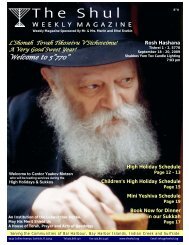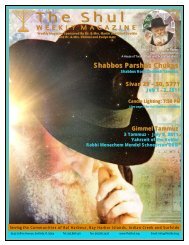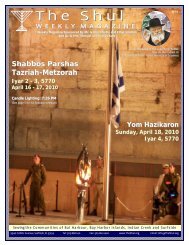You also want an ePaper? Increase the reach of your titles
YUMPU automatically turns print PDFs into web optimized ePapers that Google loves.
Inspiration, Insights & Ideas<br />
Bringing Torah lessons to LIFE!<br />
Saturday night, 30 hired hands, of which 15 were chefs, and a large<br />
number of Israeli tourists arrived at Chabad to help for the Seder, all<br />
under the guidance of Yael Kripor. Cleaning, washing, cooking,<br />
checking vegetables for bugs. A small group was also drawing the<br />
Seder steps on large placards. This work lasted until Monday<br />
afternoon.<br />
Monday at 2pm, a truck came to the Chabad House to haul all the<br />
food and equipment to the hall in which the Seder would take place.<br />
We too, finished our preparations and took a few pairs of tefillin with<br />
us, and drove to the hall.<br />
On the way, Rabbi Ofer told us that in the morning he met with the<br />
Cusco sheriff and 12 colonels regarding security for the event. When<br />
we neared the hall, we saw that all the surrounding streets were<br />
blocked off, so we parked the car and walked the distance to the hall.<br />
Police forces were spread across the entire area, and we saw snipers<br />
on rooftops. We passed no less than three security screenings before<br />
being allowed into the hall itself, where we met a security agent<br />
contracted for this project from the Israelis. He told us that there<br />
were some 170 of Cusco’s police and 30 Israeli tourists – themselves<br />
veterans of special unit forces of the IDF – dispersed the breadth of<br />
the area to secure our Passover Seder event. He confirmed that his<br />
superiors in Israel had advised him that this would be the “biggest<br />
Seder in the world.”<br />
An Astounding View<br />
The sight of the huge hall, set with 1,200-plus seats was stunning. At<br />
around 4:30pm the guests started arriving. At the hall entrance, we<br />
opened our tefillin bags and started wrapping tefillin with the guests.<br />
There was no rest until sunset.<br />
When the hall was full, the women lit holiday candles and the men<br />
went to pray the maariv evening prayer. Guests then made their way<br />
to the tables. Rabbi Ofer divided the hall between us (eight students)<br />
into four groups, making each pair of rabbinical students “in charge”<br />
of 300 people.<br />
The Rabbi himself got up on a chair in middle of the hall and spoke<br />
loudly, laying out the schedule. He requested that no one take<br />
photos during the event out of respect for the holiday. At the end he<br />
raised the first large placard: Kaddesh. The eight of us followed with<br />
our placards.<br />
The enormous hall filled with more than 1200 people was silent. The<br />
waiters came in and filled every individual's cup and the Rabbi made<br />
Kiddush reminding everyone to drink their Kiddush while reclining.<br />
We proceeded with Urchatz, Karpas, Yachatz.<br />
Maggid was extraordinary. Each of the four groups sang one of the<br />
Four Questions of the Ma Nishtana, and so we continued the<br />
haggadah while every page and a half, the entire hall joined the<br />
singing.<br />
What amazed me and my friends was that we indeed did not see a<br />
single camera throughout the duration of the Seder, which added<br />
immensely to the spirit of holiday. Clearly, Rabbi Ofer had the ear and<br />
respect of his guests.<br />
The Rabbi lifted the placard of Rachtza and everybody got up to wash<br />
while the waiters rushed in to bring everyone their matzah. Silence<br />
again. The Rabbi made the blessing and all followed. No one spoke,<br />
as is the tradition, while they broke and ate the first of the matzah.<br />
And so the Seder continued: marror, korech...<br />
Chad Gadya<br />
Shulchan Orech. The evening moved along without too much<br />
Recently in the News<br />
17<br />
interruption. The kitchen staff moved like clockwork. There was<br />
plenty of food for everyone. Salads, soup, chicken . . . I and the other<br />
rabbinical students went table hopping, giving us a chance to chat<br />
with groups of guests and share some of the Rebbe’s insights on the<br />
Haggadah, tell stories and sing.<br />
Towards the end, Rabbi Ofer got up on a chair and announced that<br />
most of the evening is now behind us, “but the best part is yet to<br />
come.” We weren’t sure what he meant until the hall reverberated<br />
with the Chad Gadya. I haven’t experienced such lively spirit in a very<br />
long time. It was as if the entire Cusco was singing and dancing<br />
together with us.<br />
Slowly people started to leave. We remained with a small group of<br />
people, singing holiday songs and discussing Torah thoughts deep<br />
into the night. On my way out, as I passed Rabbi Ofer speaking with<br />
the heads of the Israeli security personnel, I overheard one of them<br />
tell him, “The cords of my soul were vibrating to the songs of this<br />
Seder.”<br />
Next year in Jerusalem.<br />
<br />
T<br />
he Sanhedria Children's Home in Jerusalem is a residential<br />
rehabilitation center for extremely disadvantaged boys aged 6-<br />
18 years old. The children suffered severe forms of emotional<br />
and physical abuse and neglect in their early childhood and<br />
subsequently were removed from their parents custody by court<br />
order. Sanhedria is these children's first experience in a loving and<br />
stable home. A dedicated professional staff provides the boys with<br />
skills to manage their pain. Therapeutic programs and activities,<br />
many with the participation of yeshiva and seminary volunteers<br />
brighten up the children's orbit. Miriam Braun, director of program<br />
development at Sanhedria visited Florida earlier this year and spoke<br />
at our Rebbetzin's Parsha class where she told of the children's plight.<br />
One of The Shul's members, who asked to remain<br />
anonymous, hooked Sanhedria up with Soles for Souls, an<br />
organization that provides shoes for the needy. The new sport shoes,<br />
lovingly repacked and shipped to Jerusalem by our congregant<br />
arrived over Pesach and the children delighted in their new gear! In<br />
addition to meeting a physical need, the beautiful new shoes lifted<br />
the children's spirits and feelings of self-esteem.<br />
To find out how you can help the children, please visit Sanhedria's<br />
website at: www.sanhedria.co.il or call their U.S. toll free # 866 409<br />
5718. Our members are also invited to visit the facility and meet the<br />
children when in Jerusalem. Visits should be coordinated with Ms.<br />
Braun at Israel cell 0504 566526 or via e-mail:<br />
tara_br@netvision.net.il














